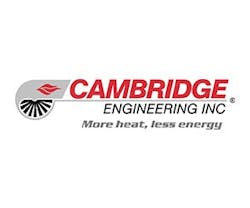Cambridge Engineering, The leader in energy efficient heating and ventilating technologies
Our industry leading 100% outside air High Discharge Temperature Heating and Ventilation (HTHV) direct fired heating technologies are the most energy efficient way to heat both commercial and industrial buildings. Cambridge’s heaters also have the industry's highest temperature rise and Btu/cfm ratio.
Starting at 250,000 Btus, our SA-series heaters are the most energy efficient way to heat buildings with 25,000 s/f or less. For larger spaces, 25,000 s/f and up, our S-series heaters provide heating solutions up to 3.2 million Btus from a single heater.
With 100% outside air HTHV technology, and the high velocity discharge that is standard on our heaters, you get three different pieces of equipment in one energy efficient Cambridge heater. Our HTHV direct fired heater is a 92% efficient heater. Because we heat with 100% outside air we also ventilate the building and because of our high velocity discharge we also de-stratify the air within the space. So instead of installing a heater, ventilation fans, and de-stratification fans all you have to do is install one Cambridge 100% outside air HTHV heater and you get all three in one unit.
Recently Cambridge conducted a study with the Department of Energy to compare the energy usage of a 100% outside air HTHV heater vs. a standard unit heater. The following is the results of the study:
HTHV Technology reduces natural gas consumption by at least 20%
Cambridge Engineering’s high-efficiency, 100% outside air High Discharge Temperature Heating & Ventilating (HTHV) gas-fired space heating technology consumes significantly less energy than a conventional gas unit heater. Recently, the Department of Energy conducted a field demonstration to analyze the energy savings from 100% outside air HTHV direct-fired gas heaters, under normal use conditions at a warehouse outside of St. Louis, MO.
The project successfully demonstrated the energy savings of 100% outside air, HTHV direct-fired gas heaters from improved thermal efficiency, reduced temperature stratification, higher discharge temperature, and positive pressurization over a standard-efficiency unit heater meeting federal and state appliance standards.
The study was conducted over the majority of the 2013–2014 heating season (October 2013 through mid-March 2014) at a single-story warehouse with approximately 41,667 sq/ft. of heated warehouse and loading space and approximately 24 ft. high ceilings.
Demonstration Performance
In a side-by-side comparison in alternating months over the 2013–2014 heating season, the new gas heaters demonstrated the following benefits:
• Energy Savings (therms, kWh)
The new gas heaters consumed 20% less natural gas compared to the existing unit heaters at average utility rates for the site of $0.8/therm.
• Performance
The new gas heaters reduced temperature stratification and maintained more uniform and comfortable temperature distribution.
Key Takeaways
• High-efficiency gas heaters used 20% less natural gas and cost 15% less to operate in a side-by-side comparison to standard equipment. Savings – $1,272/year reduction in utility costs.
• Sites could recover the extra cost of a high-efficiency gas heater versus a standard product in as few as 7 years, and often much sooner.
• The high efficiency product demonstrated in this study also reduced temperature stratification and maintained a more uniform and comfortable temperature distribution.
